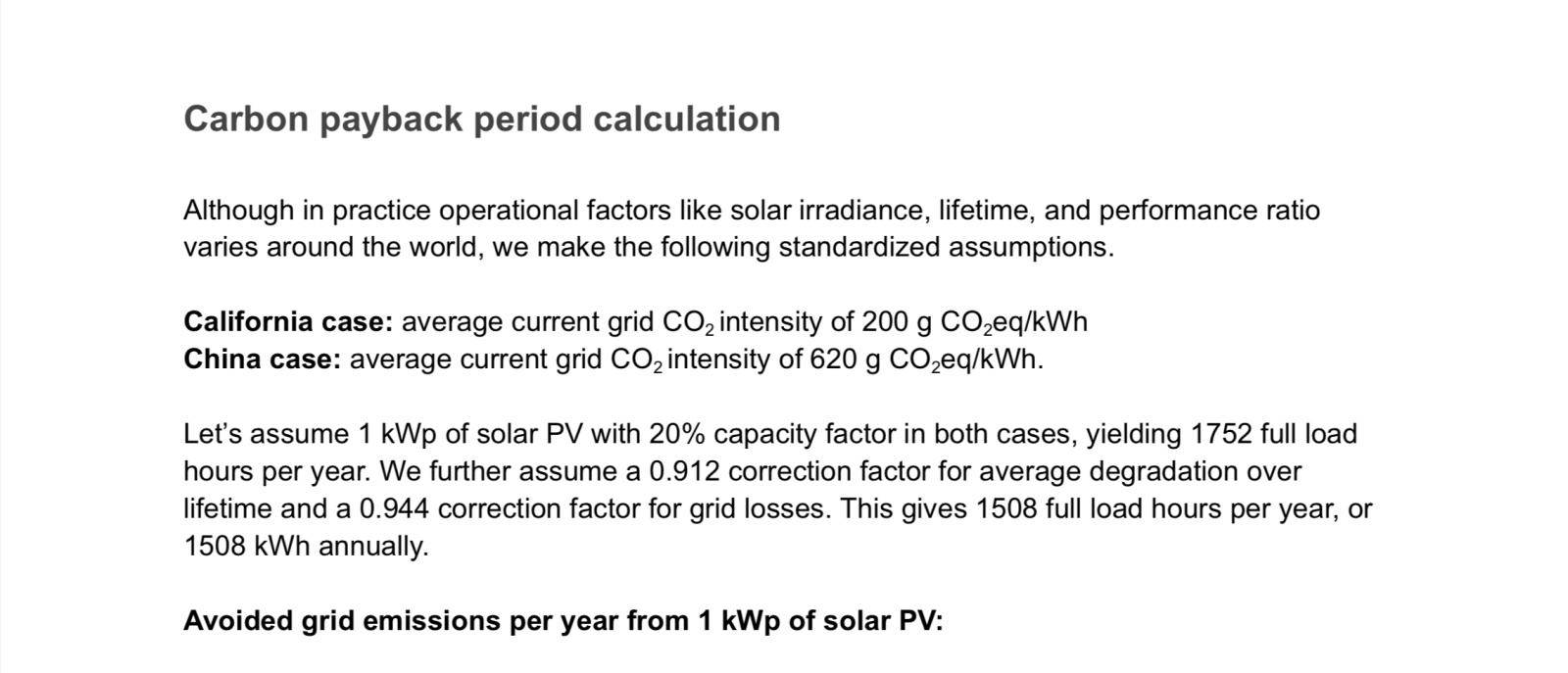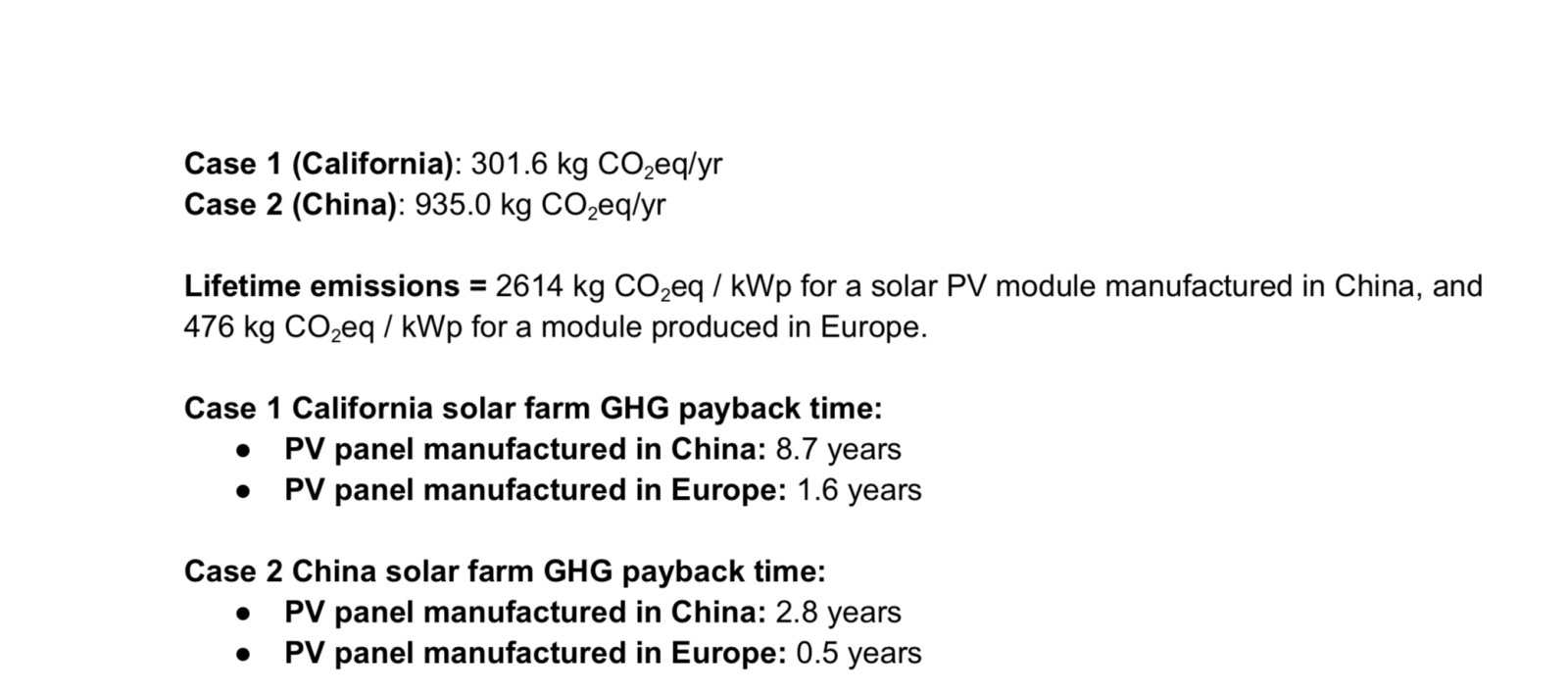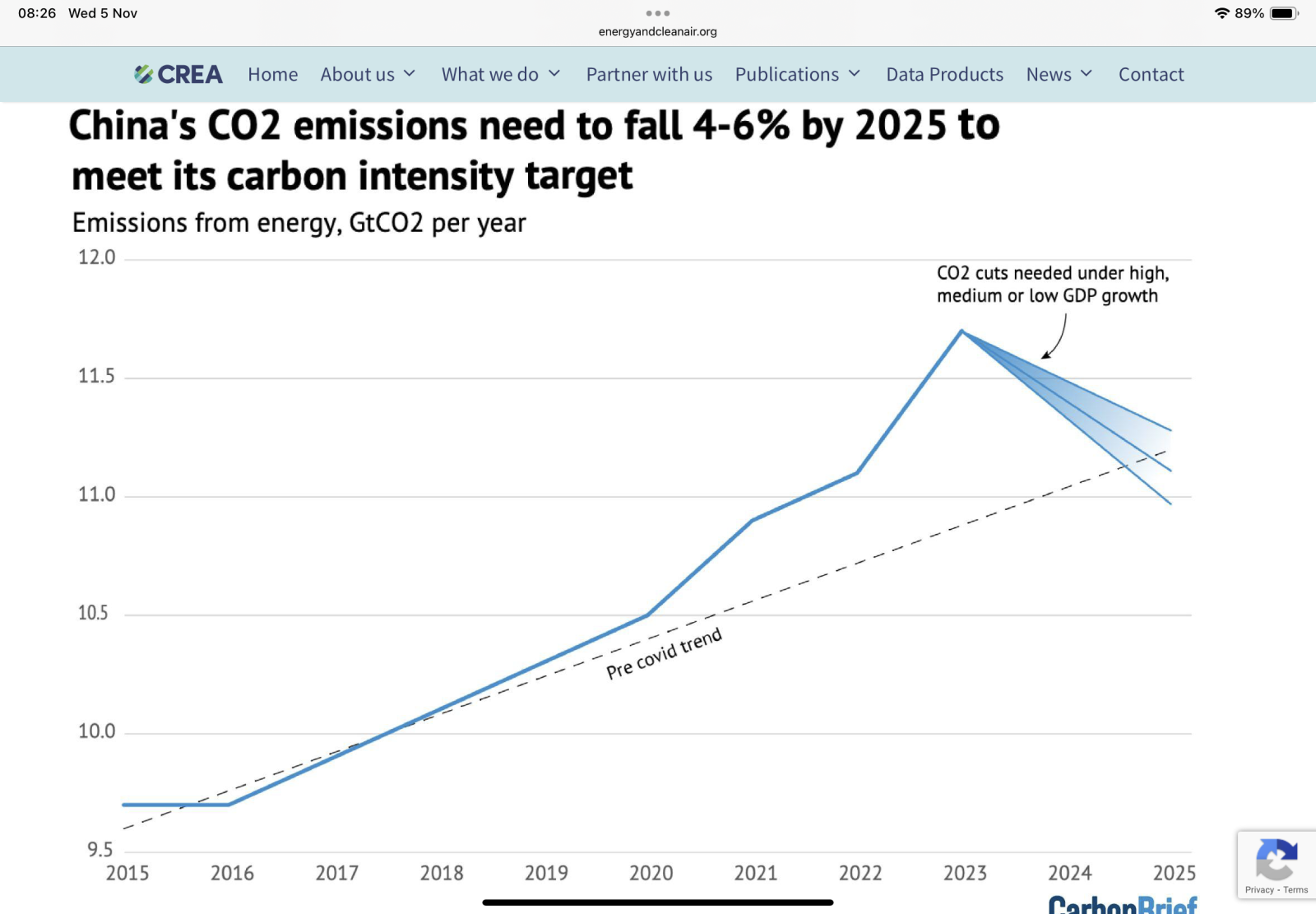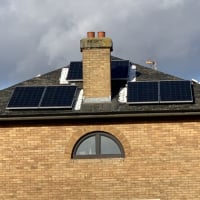We’d like to remind Forumites to please avoid political debate on the Forum.
This is to keep it a safe and useful space for MoneySaving discussions. Threads that are – or become – political in nature may be removed in line with the Forum’s rules. Thank you for your understanding.
The MSE Forum Team would like to wish you all a Merry Christmas. However, we know this time of year can be difficult for some. If you're struggling during the festive period, here's a list of organisations that might be able to help
📨 Have you signed up to the Forum's new Email Digest yet? Get a selection of trending threads sent straight to your inbox daily, weekly or monthly!
Has MSE helped you to save or reclaim money this year? Share your 2025 MoneySaving success stories!
Overexposed: a study on forced labour in Solar Panel Manufacturing (by Brand)
Comments
-
Payback comparison of Chinese and European solar panels from 2021. I couldn’t copy the text so had to use screenshots.

 https://thebreakthrough.imgix.net/pdfs/Sins-of-a-Solar-Empire-minor-tracked-corrections.pdf
https://thebreakthrough.imgix.net/pdfs/Sins-of-a-Solar-Empire-minor-tracked-corrections.pdf
This illustrates how with a dirty grid the payback time is much quicker so the carbon embedded in manufacturing is less critical. As the grid becomes cleaner the payback time is extended. For assumptions please read the linked article. You can argue about the figures but the principle remains the same.Using dirty (manufactured) panels on a dirty grid is fine as is using clean (manufactured) panels on a clean grid. However deploying dirty panels on a clean grid can seriously impact the payback calculation.Using the assumptions above (I acknowledge things have improved since 2021) using a solar panel manufactured in China in Norway which has a grid intensity of 18gCo2/kWh would not displace enough other generation to payback its embedded carbon in the panels lifetime.
In the UK with a grid intensity of 125gCO2/kWh, deploying a panel manufactured in 2021 would take almost 14 years to achieve payback. In practice over those 14 years our grid will get cleaner and cleaner so as each year goes by the payback is less. So it maybe that, even in the UK, deploying Chinese panels may actually result in a net addition to global levels of CO2 not reduce them.
And of course, as with battery manufacture we are adding huge quantities of CO2 to the atmosphere now in the hope that one day they will pay off that CO2 debt.Perhaps you don’t like the figures and maybe they are pessimistic but even so it is something we should be thinking about. Solar panels are so cheap and the electricity they produce is so cheap that it seems a no brainer to just keep rolling them out. Once we start overbuilding, though, there is a real risk that we do more harm than good from a CO2 perspective.If you just want to see a fully renewable grid because you believe that is the only answer you will dismiss this but if you do genuinely care about CO2 just have a good hard think about it.Northern Lincolnshire. 7.8 kWp system, (4.2 kw west facing panels , 3.6 kw east facing), Solis inverters, Solar IBoost water heater, Mitsubishi SRK35ZS-S and SRK20ZS-S Wall Mounted Inverter Heat Pumps, ex Nissan Leaf owner)0 -
My last post yesterday evening was really me thinking out loud and I just wanted to try and summarise. To the purist this might not be strictly true but to all intents and purposes solar (and wind) generation has no marginal CO2 cost. We should therefore generate as much solar as we can. This is absolutely fine as long as we are displacing gas or biomass (let me leave nuclear out for now). As our renewables capacity grows and we generate more than the country needs, then because that renewable generation has no marginal cost we can export it easily. So far all good. There will come a time however, say by 2030, when we will be producing more renewable energy than we need and more than our continental neighbours need. At that point we cease to displace gas and actually displace other renewable generation. As an example, the vast solar farms in Lincolnshire will be producing so much electricity on a sunny day that the electricity produced by the wind turbines in Scotland isn’t needed south of the border. At this point there is no CO2 benefit in the UK or elsewhere. We are simply displacing other CO2 free generation. As we continue to overbuild (our renewables capacity is expected to exceed demand significantly) more and more of our generation is just displacing other CO2 free generation. (Which generation source is chosen will at that point depend on pricing structures).Once, however, we reach close to 100%, or even 95%, renewable generation then, because we are no longer displacing CO2 the ability to pay back that CO2 embedded in manufacture ceases on any overbuild. To achieve 95% or 100% renewable generation will require considerable overbuilding so either much of what is built out will sit idle or it will displace other older renewable sources so they sit idle with no CO2 payback. That is the big danger of overbuildiing. At the moment because gas fills in the peaks and troughs, renewable plant doesn’t sit idle for very long, but if we are to have the generation capacity to meet our needs we have to build plant to sit idle just as we currently do with gas plant. Theoretical calculations of CO2 payback based on normal usage go out the window.
Let’s look at it from a domestic point of view. Those who put solar on their roofs in 2011 would have seen a much quicker CO2 payback than those who fitted it in 2020 even though (leaving FiT out it) the financial payback of a 2020 installation would be much quicker. Those of us putting solar on our roofs today might never see its manufacturing CO2 repaid. The sun will usually shine on my house when it is shining on the new solar farms. My generation might be financially beneficial to me but in 2030 when my panels are generating what will that generation be displacing - just generation from other solar farms so there will be no CO2 payback.I think, generally there is a notion that as solar falls in price it makes more and more financial sense to install far more than you need either domestically or as a country. Unfortunately however as we approach a clean grid the benefits from a CO2 displaced perspective disappear and you are just left with a lot of embedded CO2 sitting in increasingly idle panels.Northern Lincolnshire. 7.8 kWp system, (4.2 kw west facing panels , 3.6 kw east facing), Solis inverters, Solar IBoost water heater, Mitsubishi SRK35ZS-S and SRK20ZS-S Wall Mounted Inverter Heat Pumps, ex Nissan Leaf owner)0 -
You need to revise your workings, it’s not just the manufacturing CO2 shipping is the elephant in the room.4.8kWp 12x400W Longhi 9.6 kWh battery Giv-hy 5.0 Inverter, WSW facing Essex . Aint no sunshine ☀️ Octopus gas fixed dec 24 @ 5.74 tracker again+ Octopus Intelligent Flux leccy0
-
JKenH said:
The link you provided refers to China as a whole. The figure of 100% coal generation I quoted came from the July/November 2023 report from Sheffield Hallam not a 2017 report. The 1016 g/kWh figure I quoted was from a 2017 report but that simply was a figure for the CO2 emissions from coal generated electricity and was not time sensitive.Magnitio said:JKenH said:A 100% coal powered grid as in the Uyghur region in China which is the subject of the report is estimated at 1016 g/kWh. https://www.researchgate.net/publication/353549276_Research_on_carbon_emission_of_coal-fired_power_in_ChinaYou are quoting a report from 2017. I'm sure you won't be suprised to hear that things have moved on a bit since then. Here's some up-to-date data from this region:"In 2024, more than 30 percent, or 39.2 billion kWh, came from renewable energy, helping reduce standard coal consumption by 11.86 million tonnes and cut carbon dioxide emissions by 32.02 million tonnes.The region also leads in new-type energy storage, with installed capacity exceeding 10 million kilowatts"China's emissions are now estimated to be below 500g/kWh, so half the figure you quote.Edit: I am genuinely surprised at the pushback against criticism of China’s manufacture of solar panels using forced labour and fossil fuels. Do you really approve of what’s going on in Uyghur?I was simply providing some alternative information to provide balance to your "facts" that come from biased, selective research.I am in no way on here to support China or defend their human-rights issues. However, they are making significant progress in decarbonising their energy usage.
6.4kWp (16 * 400Wp REC Alpha) facing ESE + 5kW Huawei inverter + 10kWh Huawei battery. Buckinghamshire.0 -
Some alternative information for a manufacturer of solar panels that is very conscious of the carbon footprint of solar panels. This is the manufacturer we chose for our installation.
6.4kWp (16 * 400Wp REC Alpha) facing ESE + 5kW Huawei inverter + 10kWh Huawei battery. Buckinghamshire.0 -
debitcardmayhem said:You need to revise your workings, it’s not just the manufacturing CO2 shipping is the elephant in the room.Do I?

https://www.ise.fraunhofer.de/content/dam/ise/de/documents/publications/studies/Photovoltaics-Report.pdf
Northern Lincolnshire. 7.8 kWp system, (4.2 kw west facing panels , 3.6 kw east facing), Solis inverters, Solar IBoost water heater, Mitsubishi SRK35ZS-S and SRK20ZS-S Wall Mounted Inverter Heat Pumps, ex Nissan Leaf owner)1 -
Thank you. Yes, that’s much better than China and demonstrates the benefit of sourcing panels from a country with high renewable generation.Magnitio said:Some alternative information for a manufacturer of solar panels that is very conscious of the carbon footprint of solar panels. This is the manufacturer we chose for our installation.Northern Lincolnshire. 7.8 kWp system, (4.2 kw west facing panels , 3.6 kw east facing), Solis inverters, Solar IBoost water heater, Mitsubishi SRK35ZS-S and SRK20ZS-S Wall Mounted Inverter Heat Pumps, ex Nissan Leaf owner)1 -
Hmmm. This graph suggests otherwise.Magnitio said:JKenH said:
The link you provided refers to China as a whole. The figure of 100% coal generation I quoted came from the July/November 2023 report from Sheffield Hallam not a 2017 report. The 1016 g/kWh figure I quoted was from a 2017 report but that simply was a figure for the CO2 emissions from coal generated electricity and was not time sensitive.Magnitio said:JKenH said:A 100% coal powered grid as in the Uyghur region in China which is the subject of the report is estimated at 1016 g/kWh. https://www.researchgate.net/publication/353549276_Research_on_carbon_emission_of_coal-fired_power_in_ChinaYou are quoting a report from 2017. I'm sure you won't be suprised to hear that things have moved on a bit since then. Here's some up-to-date data from this region:"In 2024, more than 30 percent, or 39.2 billion kWh, came from renewable energy, helping reduce standard coal consumption by 11.86 million tonnes and cut carbon dioxide emissions by 32.02 million tonnes.The region also leads in new-type energy storage, with installed capacity exceeding 10 million kilowatts"China's emissions are now estimated to be below 500g/kWh, so half the figure you quote.Edit: I am genuinely surprised at the pushback against criticism of China’s manufacture of solar panels using forced labour and fossil fuels. Do you really approve of what’s going on in Uyghur?I was simply providing some alternative information to provide balance to your "facts" that come from biased, selective research.I am in no way on here to support China or defend their human-rights issues. However, they are making significant progress in decarbonising their energy usage.
https://energyandcleanair.org/analysis-record-drop-in-chinas-co2-emissions-needed-to-meet-2025-target/
Northern Lincolnshire. 7.8 kWp system, (4.2 kw west facing panels , 3.6 kw east facing), Solis inverters, Solar IBoost water heater, Mitsubishi SRK35ZS-S and SRK20ZS-S Wall Mounted Inverter Heat Pumps, ex Nissan Leaf owner)0 -
While I agree with the sentiment expressed, I don't see capacity rising quite as much. The wind industry is in serious consolidation mode in the Trump era, with Hornsea 4 having been cancelled.JKenH said:There will come a time however, say by 2030, when we will be producing more renewable energy than we need and more than our continental neighbours need. At that point we cease to displace gas and actually displace other renewable generation. As an example, the vast solar farms in Lincolnshire will be producing so much electricity on a sunny day that the electricity produced by the wind turbines in Scotland isn’t needed south of the border. At this point there is no CO2 benefit in the UK or elsewhere. We are simply displacing other CO2 free generation. As we continue to overbuild (our renewables capacity is expected to exceed demand significantly) more and more of our generation is just displacing other CO2 free generation. (Which generation source is chosen will at that point depend on pricing structures).Once, however, we reach close to 100%, or even 95%, renewable generation then, because we are no longer displacing CO2 the ability to pay back that CO2 embedded in manufacture ceases on any overbuild. To achieve 95% or 100% renewable generation will require considerable overbuilding so either much of what is built out will sit idle or it will displace other older renewable sources so they sit idle with no CO2 payback. That is the big danger of overbuildiing. At the moment because gas fills in the peaks and troughs, renewable plant doesn’t sit idle for very long, but if we are to have the generation capacity to meet our needs we have to build plant to sit idle just as we currently do with gas plant. Theoretical calculations of CO2 payback based on normal usage go out the window.
Solar clearly has room to grow with < 45% of the total UK generation mix (across all fuel sources) on its best day to date. That said, I don't see a world where Grade 1, 2 or 3a agricultural land will be used at scale for power generation in a food insecure world, even under this government.
The original point of this thread was to highlight the ethics (or lack thereof) of several PV component manufacturers, which I very much doubt the Solar farm planners are taking into consideration at any level.- 10 x 400w LG Bifacial + 6 x 550W SHARP BiFacial + 2 x 570W SHARP Bifacial + 5kW SolarEdge Inverter + SolarEdge Optimizers. SE London.
- Triple aspect. (33% ENE.33% SSE. 34% WSW)
- Viessmann 200-W on Advanced Weather Comp. (The most efficient gas boiler sold)Feel free to DM me for help with any form of energy saving! Happy to help!0 -
JKenH said:
Hmmm. This graph suggests otherwise.Magnitio said:JKenH said:
The link you provided refers to China as a whole. The figure of 100% coal generation I quoted came from the July/November 2023 report from Sheffield Hallam not a 2017 report. The 1016 g/kWh figure I quoted was from a 2017 report but that simply was a figure for the CO2 emissions from coal generated electricity and was not time sensitive.Magnitio said:JKenH said:A 100% coal powered grid as in the Uyghur region in China which is the subject of the report is estimated at 1016 g/kWh. https://www.researchgate.net/publication/353549276_Research_on_carbon_emission_of_coal-fired_power_in_ChinaYou are quoting a report from 2017. I'm sure you won't be suprised to hear that things have moved on a bit since then. Here's some up-to-date data from this region:"In 2024, more than 30 percent, or 39.2 billion kWh, came from renewable energy, helping reduce standard coal consumption by 11.86 million tonnes and cut carbon dioxide emissions by 32.02 million tonnes.The region also leads in new-type energy storage, with installed capacity exceeding 10 million kilowatts"China's emissions are now estimated to be below 500g/kWh, so half the figure you quote.Edit: I am genuinely surprised at the pushback against criticism of China’s manufacture of solar panels using forced labour and fossil fuels. Do you really approve of what’s going on in Uyghur?I was simply providing some alternative information to provide balance to your "facts" that come from biased, selective research.I am in no way on here to support China or defend their human-rights issues. However, they are making significant progress in decarbonising their energy usage.
https://energyandcleanair.org/analysis-record-drop-in-chinas-co2-emissions-needed-to-meet-2025-target/Yet again, you are quoting out of date information. We are already nearing the end of 2025, not 2023. Here's something that is more up-to-date from the same source:
6.4kWp (16 * 400Wp REC Alpha) facing ESE + 5kW Huawei inverter + 10kWh Huawei battery. Buckinghamshire.0
Confirm your email address to Create Threads and Reply

Categories
- All Categories
- 352.9K Banking & Borrowing
- 253.9K Reduce Debt & Boost Income
- 454.7K Spending & Discounts
- 246K Work, Benefits & Business
- 602.1K Mortgages, Homes & Bills
- 177.8K Life & Family
- 259.9K Travel & Transport
- 1.5M Hobbies & Leisure
- 16K Discuss & Feedback
- 37.7K Read-Only Boards




